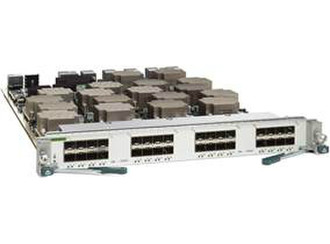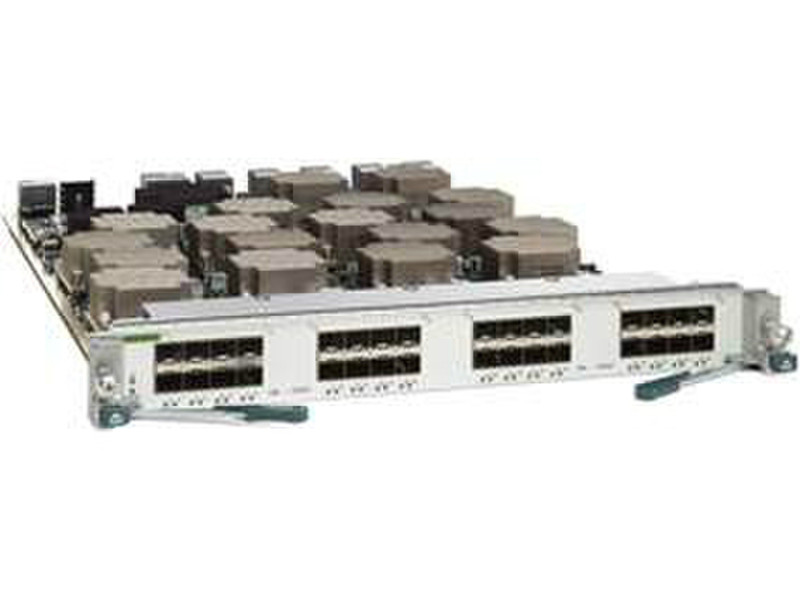目錄的
-
目錄的
- Antiquitäten & Kunst
- Auto & Motorrad: Fahrzeuge
- Baby
- Bücher
- Camping & Outdoor
- Feinschmecker
- Haustierbedarf
- Heimwerken & Garten
- IT和电子
- Kleidung & Accessoires
- Modellbau
- Musik
- PC- & Videospiele
- Sammeln & Seltenes
- Spielzeug
- TV, Video, DVD
- Telekommunikation
- Uhren & Schmuck
- Wellness & Beauty
- fashion & lifestyle
- institutional food services equipment
- medical equipment, accessories & supplies
- 个人护理
- 休闲爱好
- 办公设备,用品和配件
- 商业与工业
- 家居,建筑,装修
- 家用电器
- 摩托车及配件
- 武器和弹药
- 照相机
- 花园和庭院
- 运动,娱乐及休闲
- 食物
- 高保真音響
Filters
Search
Cisco N7K-F132XP-15= network switch module
凡购买和价格 (Advertising *)
顶部
技术特点
顶部
数据传输
| MAC 地址表 | 16000 entries |
|---|---|
| 转发速率 | 480 Mpps |
| VLAN 数量 | 4000 |
管理功能
| 管理平台 | Cisco DCNM 5.1 |
|---|
联网
| 全双工传输 | Y |
|---|---|
| 流量控制支持 | Y |
| 以太网的数据传输率 | 1000, 10000 Mbit/s |
认证标准
| 安全 | UL/CSA/IEC/EN 60950-1, AS/NZS 60950 |
|---|---|
| 电磁兼容性 | FCC Part 15 (CFR 47) (USA) Class A, ICES-003 (Canada) Class A, EN55022 (Europe) Class A, CISPR22 (International) Class A, AS/NZS CISPR22 (Australia and New Zealand) Class A, VCCI (Japan) Class A, KN22 (Korea) Class A, CNS13438 (Taiwan) Class A, CISPR24, EN55024, EN50082-1, EN61000-3-2, EN61000-3-3, EN61000-6-1, EN300 386 |
能量控制
| 支持以太网(PoE) | N |
|---|
安全
| 存取控制清单(ACL) | Y |
|---|
端口 & 界面
| 光纤通道端口 | 32 |
|---|
另外
| 巨型帧 | Y |
|---|
Nexus 7000 - 32x 1G/10G Ethernet Module, SFP/SFP+, Spare
The Cisco Nexus® 7000 F-Series 32-Port 1 and 10 Gigabit Ethernet Module offers outstanding flexibility and performance, with extensive virtualization and multipath capabilities. The module enables the deployment of high-density, low-latency, scalable data center architecture.
The Cisco Nexus 7000 F-Series 32-Port 1 and 10 Gigabit Ethernet Module is the first of the Cisco Nexus 7000 F-Series Ethernet modules, extending the capabilities of the Cisco Nexus 7000 Series in the data center. Powered by the F1 forwarding engine, the module delivers 480 million packets per second (Mpps) of distributed Layer 2 forwarding and up to 320 Gbps of data throughput through a custom dedicated forwarding application- specific integrated circuit (ASIC), enabling the creation of extensible data centers. A Cisco Nexus 7000 18-Slot Switch fully populated with Cisco Nexus F-Series 32-Port 1 and 10 Gigabit Ethernet Modules has the capability to deliver up to 10.2 terabits per second (Tbps) of switching performance, with a typical power consumption of less than 10 watts (W) per port.
Powerful access control list (ACL) processing supports 32,000 per module, ingress and egress, with the ACL entries addressing Layer 2, 3, and 4 fields. The F1 forwarding engine also supports applications requiring port mirroring, with integrated hardware support for 16 simultaneous unidirectional Cisco Switched Port Analyzer (SPAN) sessions per module. Additionally, the F-Series module delivers integrated Fibre Channel over Ethernet (FCoE), greatly simplifying the network infrastructure and reducing costs by enabling the deployment of unified data center fabrics to consolidate data center traffic onto a single, general-purpose, high-performance, highly available network.
With the Cisco Nexus 7000 F-Series module, FCoE can be deployed in director-class modular platforms for the access and core of converged networks. In addition to FCoE host and target support, the module provides VE-port support, allowing creation of FCoE Inter-Switch Links (ISLs) and enabling scalable, multihop FCoE topologies. The FCoE traffic in a Cisco Nexus 7000 Series Switch can be segmented using a dedicated storage virtual device context (VDC), providing isolation within the shared physical infrastructure. Cisco Nexus 7000 Series FCoE converged networks can be transparently bridged to Cisco® MDS 9500 Series Fibre Channel SANs with the Cisco MDS 10-Gbps 8-Port FCoE Module. This capability preserves existing and continued investments in Fibre Channel SANs and offers a single unified OS (Cisco NX-OS Software) and management platform (Cisco Data Center Network Manager [DCNM]) for both the LAN and SAN.
The Cisco Nexus 7000 F-Series modules, when combined with the powerful Cisco NX-OS Software, deliver Cisco FabricPath multipath Ethernet technologies based on IETF Transparent Interconnection of Lots of Links (TRILL). Cisco FabricPath comprises a set of multipath Ethernet technologies and combines the reliability and scalability benefits of Layer 3 routing with the flexibility of Layer 2 Ethernet networks. With Cisco FabricPath, organizations can now build massively scalable, flexible networks that efficiently use available bandwidth between nodes, offering improved network resiliency.
Cisco FabricPath offers a topology-based Layer 2 routing mechanism that provides an equal-cost multipath (ECMP) forwarding model. Cisco FabricPath implements an enhancement that resolves the MAC address table scalability challenge characteristic of switched Layer 2 networks. Enhanced virtual PortChannel (vPC+) is another technology offered by Cisco FabricPath. Similar to vPC, vPC+ allows the redundant interconnection of the existing Ethernet infrastructure to a Cisco FabricPath fabric without relying on Spanning Tree Protocol.
The benefits of Cisco FabricPath include:
- Operational simplicity: Cisco FabricPath embeds an autodiscovery mechanism that does not require any additional platform configuration. By offering Layer 2 connectivity, this “VLAN anywhere” characteristic simplifies provisioning and offers workload flexibility across the network.
- High resiliency and performance: Because Cisco FabricPath is a Layer 2 routed protocol, it offers stability, scalability, and optimized resiliency along with network failure containment.
- Massively scalable fabric: By building a forwarding model on 16-way ECMP, Cisco FabricPath helps prevent bandwidth bottlenecks and allows capacity to be added dynamically, without network disruption.
The Cisco Nexus 7000 F-1 Series 32-Port 1 and 10 Gigabit Ethernet Module delivers up to 512 ports per chassis capable of flexibly supporting both Gigabit and 10 Gigabit Ethernet on a per-port basis. Both Small Form-Factor Pluggable (SFP) and Enhanced SFP (SFP+) optics are available for long- and short-haul applications, including Twinax support, for rack-to-rack data center applications, enabling migration and support for numerous deployment scenarios requiring different media types. Table 1 summarizes the features and benefits of the Cisco Nexus 7000 F1-Series 32-Port 1 and 10 Gigabit Ethernet Module.
The Cisco Nexus 7000 F-Series 32-Port 1 and 10 Gigabit Ethernet Module is the first of the Cisco Nexus 7000 F-Series Ethernet modules, extending the capabilities of the Cisco Nexus 7000 Series in the data center. Powered by the F1 forwarding engine, the module delivers 480 million packets per second (Mpps) of distributed Layer 2 forwarding and up to 320 Gbps of data throughput through a custom dedicated forwarding application- specific integrated circuit (ASIC), enabling the creation of extensible data centers. A Cisco Nexus 7000 18-Slot Switch fully populated with Cisco Nexus F-Series 32-Port 1 and 10 Gigabit Ethernet Modules has the capability to deliver up to 10.2 terabits per second (Tbps) of switching performance, with a typical power consumption of less than 10 watts (W) per port.
Powerful access control list (ACL) processing supports 32,000 per module, ingress and egress, with the ACL entries addressing Layer 2, 3, and 4 fields. The F1 forwarding engine also supports applications requiring port mirroring, with integrated hardware support for 16 simultaneous unidirectional Cisco Switched Port Analyzer (SPAN) sessions per module. Additionally, the F-Series module delivers integrated Fibre Channel over Ethernet (FCoE), greatly simplifying the network infrastructure and reducing costs by enabling the deployment of unified data center fabrics to consolidate data center traffic onto a single, general-purpose, high-performance, highly available network.
With the Cisco Nexus 7000 F-Series module, FCoE can be deployed in director-class modular platforms for the access and core of converged networks. In addition to FCoE host and target support, the module provides VE-port support, allowing creation of FCoE Inter-Switch Links (ISLs) and enabling scalable, multihop FCoE topologies. The FCoE traffic in a Cisco Nexus 7000 Series Switch can be segmented using a dedicated storage virtual device context (VDC), providing isolation within the shared physical infrastructure. Cisco Nexus 7000 Series FCoE converged networks can be transparently bridged to Cisco® MDS 9500 Series Fibre Channel SANs with the Cisco MDS 10-Gbps 8-Port FCoE Module. This capability preserves existing and continued investments in Fibre Channel SANs and offers a single unified OS (Cisco NX-OS Software) and management platform (Cisco Data Center Network Manager [DCNM]) for both the LAN and SAN.
The Cisco Nexus 7000 F-Series modules, when combined with the powerful Cisco NX-OS Software, deliver Cisco FabricPath multipath Ethernet technologies based on IETF Transparent Interconnection of Lots of Links (TRILL). Cisco FabricPath comprises a set of multipath Ethernet technologies and combines the reliability and scalability benefits of Layer 3 routing with the flexibility of Layer 2 Ethernet networks. With Cisco FabricPath, organizations can now build massively scalable, flexible networks that efficiently use available bandwidth between nodes, offering improved network resiliency.
Cisco FabricPath offers a topology-based Layer 2 routing mechanism that provides an equal-cost multipath (ECMP) forwarding model. Cisco FabricPath implements an enhancement that resolves the MAC address table scalability challenge characteristic of switched Layer 2 networks. Enhanced virtual PortChannel (vPC+) is another technology offered by Cisco FabricPath. Similar to vPC, vPC+ allows the redundant interconnection of the existing Ethernet infrastructure to a Cisco FabricPath fabric without relying on Spanning Tree Protocol.
The benefits of Cisco FabricPath include:
- Operational simplicity: Cisco FabricPath embeds an autodiscovery mechanism that does not require any additional platform configuration. By offering Layer 2 connectivity, this “VLAN anywhere” characteristic simplifies provisioning and offers workload flexibility across the network.
- High resiliency and performance: Because Cisco FabricPath is a Layer 2 routed protocol, it offers stability, scalability, and optimized resiliency along with network failure containment.
- Massively scalable fabric: By building a forwarding model on 16-way ECMP, Cisco FabricPath helps prevent bandwidth bottlenecks and allows capacity to be added dynamically, without network disruption.
The Cisco Nexus 7000 F-1 Series 32-Port 1 and 10 Gigabit Ethernet Module delivers up to 512 ports per chassis capable of flexibly supporting both Gigabit and 10 Gigabit Ethernet on a per-port basis. Both Small Form-Factor Pluggable (SFP) and Enhanced SFP (SFP+) optics are available for long- and short-haul applications, including Twinax support, for rack-to-rack data center applications, enabling migration and support for numerous deployment scenarios requiring different media types. Table 1 summarizes the features and benefits of the Cisco Nexus 7000 F1-Series 32-Port 1 and 10 Gigabit Ethernet Module.
-
支付方式
我们接受:











